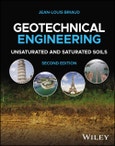While there are many textbooks on the market that cover geotechnical engineering basics, Geotechnical Engineering is unique in that it is the only textbook available that is rooted within the three phase unsaturated soil mechanics framework. Written by world-renowned, award-winning geotechnical engineering expert Dr. Jean-Louis Briaud, this Second Edition offers the most comprehensive coverage of geotechnical engineering topics on the market, from theory to real-world application.
In addition to many updates and revisions, a major chapter has been added, covering 22 geo-engineering case histories. They are: - Washington Monument (shallow mat foundation) - Rissa Landslide (slope stability) - Seattle 46 M-High MSE Wall (retaining wall) - The New Orleans Charity Hospital Foundation (deep foundation) - The Eurotunnel Linking France and England (tunnel) - The Teton Dam (earth dam erosion) - The Woodrow Wilson Bridge (bridge scour) - San Jacinto Monument (shallow mat foundation) - Pointe du Hoc Cliffs (rock erosion) - The Tower of PISA (shallow foundation) - The Transcona Silo (shallow foundation) - The Saint John River Bridge Abutment (slope stability) - Foundation of Briaud’s House (shrink swell soils) - The Eiffel Tower (deep foundation) - St. Isaac Cathedral (mat foundation) - National Geotechnical Experimentation Sites at Texas A&M University (full scale infrastructure tests) - The 827 M-High Burj Khalifa Tower Foundation (combined pile raft foundation) - New Orleans Levees and Katrina Hurricane (overtopping erosion) - Three Gorges Dam (concrete dam) - The Kansai International Airport (earth fill in the sea) - The Panama Canal (excavated slopes) - The Nice Airport Slope Failure (slope stability)
From site investigation and geophysics to earthquake engineering and deep foundations, Geotechnical Engineering is an ideal resource for upper-level undergraduate and graduate courses, as well as practicing professionals in geotechnical engineering and soil mechanics.
Table of Contents
Acknowledgments xxv
Chapter 1 Introduction 1
Chapter 2 Case Histories 7
Chapter 3 Engineering Geology 81
Chapter 4 Soil Components and Weight-Volume Parameters 91
Chapter 5 Soil Classification 109
Chapter 6 Rocks 127
Chapter 7 Site Investigation, Drilling, and Sampling 143
Chapter 8 In Situ Tests 171
Chapter 9 Elements of Geophysics 215
Chapter 10 Laboratory Tests 235
Chapter 11 Stresses, Effective Stress, Water Stress, Air Stress, and Strains 301
Chapter 12 Problem-Solving Methods 333
Chapter 13 Soil Constitutive Models 395
Chapter 14 Flow of Fluid and Gas Through Soils 419
Chapter 15 Deformation Properties 447
Chapter 16 Shear Strength Properties 485
Chapter 17 Thermodynamics for Soil Problems 511
Chapter 18 Shallow Foundations 523
Chapter 19 Deep Foundations 591
Chapter 20 Slope Stability 679
Chapter 21 Compaction 727
Chapter 22 Retaining Walls 743
Chapter 23 Earthquake Geoengineering 807
Chapter 24 Erosion of Soils and Scour Problems 843
Chapter 25 Geoenvironmental Engineering 893
Chapter 26 Geosynthetics 925
Chapter 27 Soil Improvement 957
Chapter 28 Technical Communications 981
References 987
Index 1005








